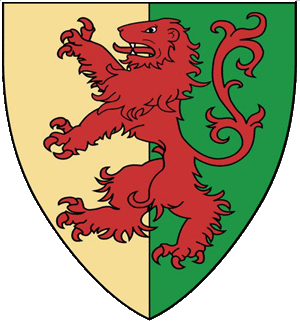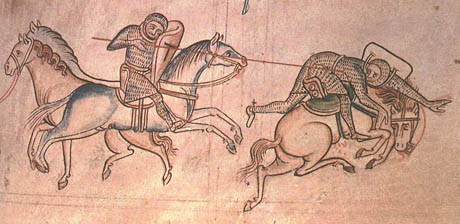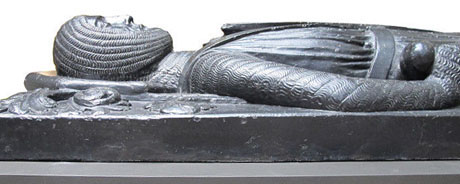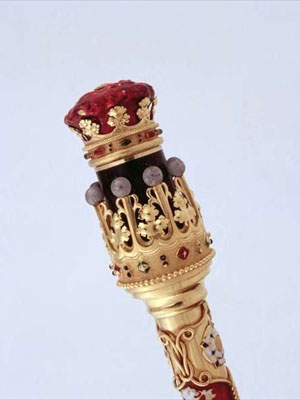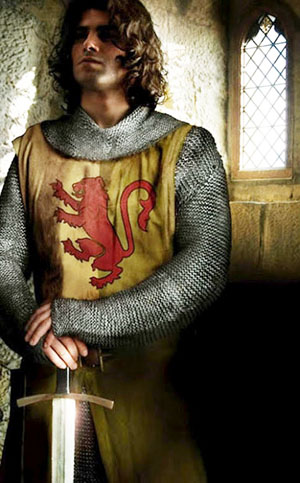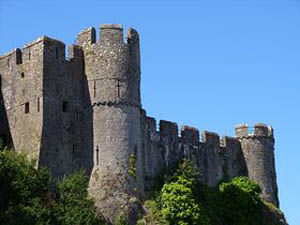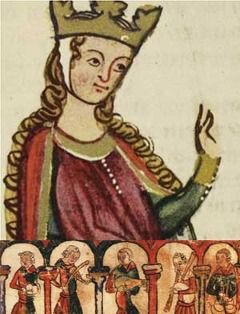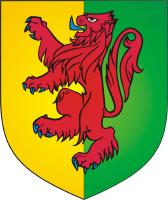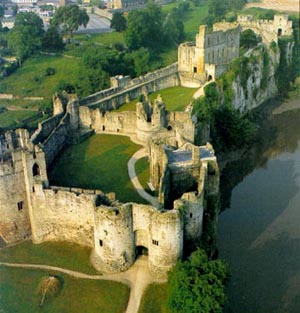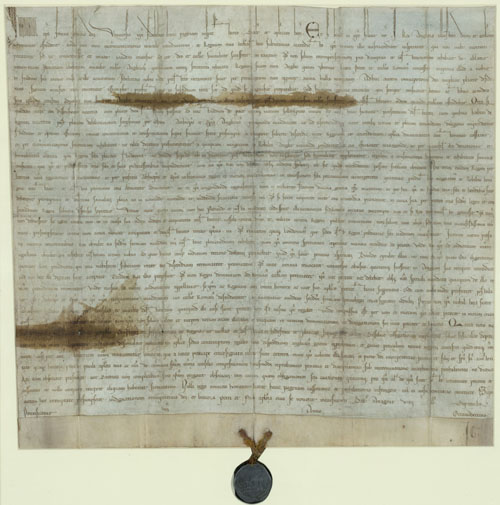William Marshal - The Flower of Chivalry |
| MEDIEVAL WARFARE |
MEDIEVAL WEAPONS |
MEDIEVAL ARMOUR |
CRUSADES
& CRUSADERS |
TEMPLARS
& HOSPITALLERS |
WILLIAM MARSHAL |
MEDIEVAL LIFE |
MEDIEVAL RE-ENACTMENT |
MEDIEVAL TORTURE |
BOOKS |
|
|
|
|
|
|||||||||||||||||||||||||||||||||||||||||||||||||
|
The name William Marshal sounds ordinary enough and could belong to any unremarkable Englishman. The chances are that you do not associate it with anyone of note. Yet William Marshal – or William the Marshal – was one of the greatest men ever to have lived and arguably the greatest ever Englishman. Although inexplicably omitted from schoolroom history he has a dozen claims to fame. He unhorsed Richard, the future King Richard I, the Lionheart, in battle and spared his life. He loyally served five Plantagenate kings, including Richard his erstwhile enemy, who had the sense to recognise Marshal's qualities. He defeated over 500 opponents in single combat, knighted two kings, ruled England as Regent, beat a powerful French army on English soil, saved the kingdom of England, and earned the respect of Europe. He was called “The Flower of Chivalry”. Stephen Langton, the Archbishop of Canterbury, described him as the "greatest knight that ever lived". Every king and great nobleman in Europe had an officer called a marshal, but by the time of his death in 1219 the whole of Europe knew William as “The Marshal&rdquo. King Stephen. William’s childhood was not easy. A generation after William the Conqueror, war raged between Stephen and Matilda, rivals for the English throne. When King Stephen besieged Newbury Castle (at Hamstead Marshall) in 1152, Stephen used the young William as a hostage to ensure that his father John Marshal surrendered the castle. John pretended to consider, but used the time to reinforce the castle and to alert Matilda's forces. Stephen then ordered John to surrender immediately or watch as he hanged William in front of the castle. John replied with the words "I still have the hammer and the anvil with which to forge yet more and better sons!". Stephen loaded William into a trebuchet ready to shoot him into the castle, but in the end could not bring himself to kill the boy. Instead William became a favourite at the royal court. As a younger son of a minor nobleman, William had no lands to inherit. Around the age of twelve he was sent to Normandy to be trained as a knight in the household of William de Tancarville, a cousin of his mother. He was knighted in 1166 on campaign in Upper Normandy. Leaving the Tancarville household he served in the household of his mother's brother, Patrick, Earl of Salisbury. In 1168 he accompanied the Earl as part of a Eleanor of Aquitaine's escort. The earl was killed in an ambush by Guy de Lusignan. William was injured but kept fighting long enough to allow Eleanor to escape. He was later ransomed by Eleanor, who had heard of his bravery. At liberty, he made a living out of winning tournaments. Tournaments were at that time dangerous – often deadly – battles, far from the showy jousting contests that they would later become late on. Money, armour, horses and valuable prizes could be won by capturing and ransoming opponents. William’s record on the tournament circuit became legendary. No modern counterpart exists, but some idea of his fame and presige might be imagined by combining the world's most famous footballer with the world heavywieght boxing champion and equestrian Olympic gold medalist. |
|
|||||||||||||||||||||||||||||||||||||||||||||||||||
|
||||||||||||||||||||||||||||||||||||||||||||||||||||
|
The Young King Henry. William’s career entered a new phase in 1170 when he was appointed to the household of Henry the Young King, the eldest surviving son of King Henry II of England. The young Henry had been crowned that year as associate king to his father. William was to be the boy's tutor-in-arms, and became his mentor and his idol. For the next twelve years he was the Young King's companion and tournament team manager. He followed the Young King in his abortive rebellion against his own father in 1173–74. William is claimed by his biographer to have knighted his young master during the course of the rebellion..
Between 1174 (when Henry was reconciled to his father) and 1182, William led the Young King’s Anglo-Norman team in all the major tournaments of the day, winning a fortune. He was recalled to the Young King's household following Henry’s second rebellion against his father. William was at his side when he died of dysentery near Limoges in 1183. William undertook to complete the crusader vow that his dead master had made, and went on crusade to the Holy Land with the approval of the bereaved father, King Henry II.
King Henry II. On his return in 1185 William joined the court of King Henry II, and served the Old King Henry as loyally as he had served the Young King Henry. In 1188 faced with an attempt by Philip II to seize the region of Berry, Henry II summoned the Marshal to join him. In the campaign, the king fell out with his heir Richard, Count of Poitou. Richard then allied himself with King Philip II against his own father. In 1189, while covering the flight of Henry II from Le Mans to Chinon, William caught Richard unawares and could have skewered him on his lance. Richard asked the William to spare his life. William killed Richard’s horse instead, to emphasise that he had had the choice. Henry died long afterwards, William supervised his funeral and burial, largely at his own cost, at Fontevraux abbey.
King Richard I. After Henry's death, William was welcomed at court by Richard, now King Richard I, who recognised and valued The Marshal's loyalty and military accomplishment. During Henry II’ last days Henry had promised William the hand and estates of Isabel de Clare, but had not completed the marriage arrangements. Richard confirmed the offer and later in 1189, at the age of 43, the Marshal married Isabel, the 17-year-old daughter and heir of Richard Strongbow. Her father had been Earl of Pembroke, and William acquired large estates in England, Wales, Normandy and Ireland. He did not immediately receive Pembroke and the title of earl, which had been taken into the king's hands in 1154, but he was granted them in 1199. This marriage transformed the landless knight into one of the richest men in the kingdom, reflecting his power and prestige at court. William and Isabel had five sons and five daughters. William made improvements to his wife's lands, including extensive additions to Pembroke Castle and Chepstow Castle. William was included in the council of regency which King Richard appointed on his departure for the Third Crusade in 1190. He took the side of John, the king's brother, when John controversially expelled the justiciar, William Longchamp, from the kingdom. William soon discovered that the interests of John did not always coincide with those of King Richard or the good of the realm. In 1193 he joined the barons loyal to Richard in making war on John. William’s elder brother was John’s Seneschal, and naturally sided with John. In spring 1194, during the course of hostilities, John Marshal was killed defending Marlborough. Richard allowed William to succeed his brother in the hereditary marshalship, and his paternal honour of Hamstead Marshall. William was now William, Marshal of England. William the Marshal served King Richard in his wars in Normandy against King Philip II. On Richard's deathbed the king designated Marshal as custodian of Rouen and of the royal treasure during the interregnum.
King John. William now served John when he became king on Richard's death in 1199. William was heavily engaged with the defence of Normandy against the French armies between 1200 and 1203. He sailed with King John when he abandoned the duchy of Normandy in December 1203. He remained loyal despite the King’s military incompetence, capriciousness and lethargy. William was sent with the Earl of Leicester as ambassadors to negotiate a truce with Philip II of France in 1204. There he took the opportunity to negotiate the continued possession of his own Norman lands. John took offence when William undertook to pay liege homage to King Philip, and there was a major row at court which led to cool relations between the two men. This coolness turned to hostility in 1207 when John began to move against major Irish magnates, including William. William left for Leinster but was recalled by the King. In 1208 John's justiciar in Ireland Meilyr fitz Henry invaded William’s lands, burning the town of New Ross. Countess Isabel, William’s wife, defeated Meilyr's army and William returned to Leinster. He was once again in conflict with King John in his war with the Briouze and Lacy families in 1210, but managed to survive. He stayed in Ireland until 1213, during which time he had Carlow Castle erected and restructured his honour of Leinster. Back in favour in 1212, he was summoned the following year to return to the English court. Despite their differences – and John’s many weaknesses – William remained loyal throughout the hostilities between John and his barons which culminated on 15 June 1215 at Runnymede with the sealing of a peace treaty that we now call Magna Carta. The Marshal witnessed it for the king while his eldest son, also called William, sealed it as one of the 25 barons named in the Security Clause. John immediately repudiated Magna Carta and at his request it was annulled by the pope, Innocent III. William, who seems never to have broken his feudal oaths of loyalty (unlike almost all of his peers) was one of the few English earls to remain loyal to the king throughout the First Barons' War. On his deathbed King John trusted William to make sure John's nine-year-old son Henry would succeed him as king. William also took responsibility for the king's funeral and burial at Worcester Cathedral. On 11 November 1216 at Gloucester, William Marshal was named by the king's council (the chief barons who had remained loyal to King John in the First Barons' War) to serve as protector of the nine year old King Henry III, and as Regent of the kingdom.
King Henry III. Before John’s death, the majority of the great barons had decided to overthrow him, and would almost certainly have succeeded if they had had William's support. As it was they had invited Prince Louis of France to take the throne of England, and Louis was now in England with an army and the support of most of the barons. In control of most of the country, Louis was crowned King of England in Westminster Abbey. On his own initiative William had Henry III crowned and voluntarily re-issued the Great Charter, Magna Carta, under his own seal, taking the precaution of having the papal legate seal it as well. As he was militarily weak, this had little effect in bringing back the rebel barons, so the civil war continued. In spite of his age (he was now around 70 years old) William prosecuted a war against Prince Louis, his French army and most of the English barons. At the battle of Lincoln he charged and fought at the head of his loyalist army, leading them to victory over a larger incumbent army, and killing his own cousin. Now the rebel barons had to think again. Before, they had planned to replace an incompetent and capricious king. Now they had a new anointed English king, whose who had done no wrong, and whose right was unquestioned, with the most respected knight in Christendom as his Regent. The indomitable William was preparing to besiege Louis in London when Hubert de Burgh won a naval engagement against Louis’s fleet in the straits of Dover. Louis was deprived of his much-needed reinforcements. The game was up. William again reissued Magna Carta in 1217, again on his own initiative and again under his own seal. The rebels no longer had a cause or a viable alternative king. Louis had been comprehensively outmanoeuvred, both militarily and diplomatically. It seems never to have occurred to him to offer to issue Magna Carta. The last few rebel barons returned to William, and Louis's claim was finished. On September 11, 1217, Marshal negotiated the Treaty of Lambeth which ended the civil war and the French invasion. William was criticised at the time for the generosity of the terms he accorded to Louis and the rebels in September 1217; but the consensus now is that his action represented, as usual, sound statesmanship. (Henry III, who had had his own doubts, would eventually realise this and would reissue Magna Carta again in 1225 and in 1229) Without the Marshal's prestige the Plantagenate dynasty might well not have survived the disastrous reign of John. While no one would trust John, everyone could trust William. Respected by all, the international sporting super-star had become the Churchill of his day. William Marshal's health failed him in February 1219. In March he realised that he was dying. He summoned his eldest son, also called William, and his household knights, and left the Tower of London for his estate at Caversham in Oxfordshire, near Reading. There he called a meeting of the barons, King Henry III, the papal legate, the royal justiciar (Hubert de Burgh), and Peter des Roches, Bishop of Winchester and the young King's guardian. William rejected the Bishop's claim to the regency and entrusted it instead to the papal legate. Fulfilling the vow he had made while on crusade, he was inducted into the order of the Knights Templar on his deathbed. He died on 14 May 1219 at Caversham, and was buried in the Temple Church in London. Although William himself is largely forgotten, you can still find vestiges of his role in English, Welsh, Irish and Norman history. For one thing you will find him in dozens of films and plays, often without his name being mentioned. He is the Earl of Pembroke in William Shakespeare's historical play King John. He makes an appearance in The Lion in Winter. (Both the 1968 and 2003 versions). Many events in his life were incorporated into the 2001 film A Knight's Tale. He is a major character in Ridley Scott's Robin Hood. Played by William Hurt he tries to convince King John to agree to the Magna Carta. Elizabeth Chadwick has written two excellent novels about his life. You can see his great castles such as Carlow Castle in Ireland, and Pembroke Castle with its great tower, and Chepstow Castle in Wales. His grave is unknown but you can still see his tomb effigy in the Temple Church in London. And one other reminder: England is not today ruled from Paris, as it would certainly have been without the Marshal’s authority and prestige to fill the power vacuum left by an incompetent king 800 years ago. And of course we still have Magna Carta - not the failed peace treaty of 1215 sealed by John under duress and annulled by the Pope - but the one still valid in English law, issued voluntarily on behalf of the king, on the initiative of and under the seal of William Marshal.
|
|
|||||||||||||||||||||||||||||||||||||||||||||||||||
|
|
||||||||||||||||||||||||||||||||||||||||||||||||||||
|
|
|
||||||||||||||||||||||||||||||||||||||||||||||||||
|
|
|
|
||||||||||||||||||||||||||||||||||||||||||||||||||
|
|
|
|||||||||||||||||||||||||||||||||||||||||||||||||||
| MEDIEVAL WARFARE |
MEDIEVAL WEAPONS |
MEDIEVAL ARMOUR |
CRUSADES
& CRUSADERS |
TEMPLARS
& HOSPITALLERS |
WILLIAM MARSHAL |
MEDIEVAL LIFE |
MEDIEVAL RE-ENACTMENT |
MEDIEVAL TORTURE |
BOOKS |
| :::: Link to us :::: Medieval Warfare Resources ::: © C&MH 2010-2013 ::: contact@medievalwarfare.info ::: Advertising ::: |


